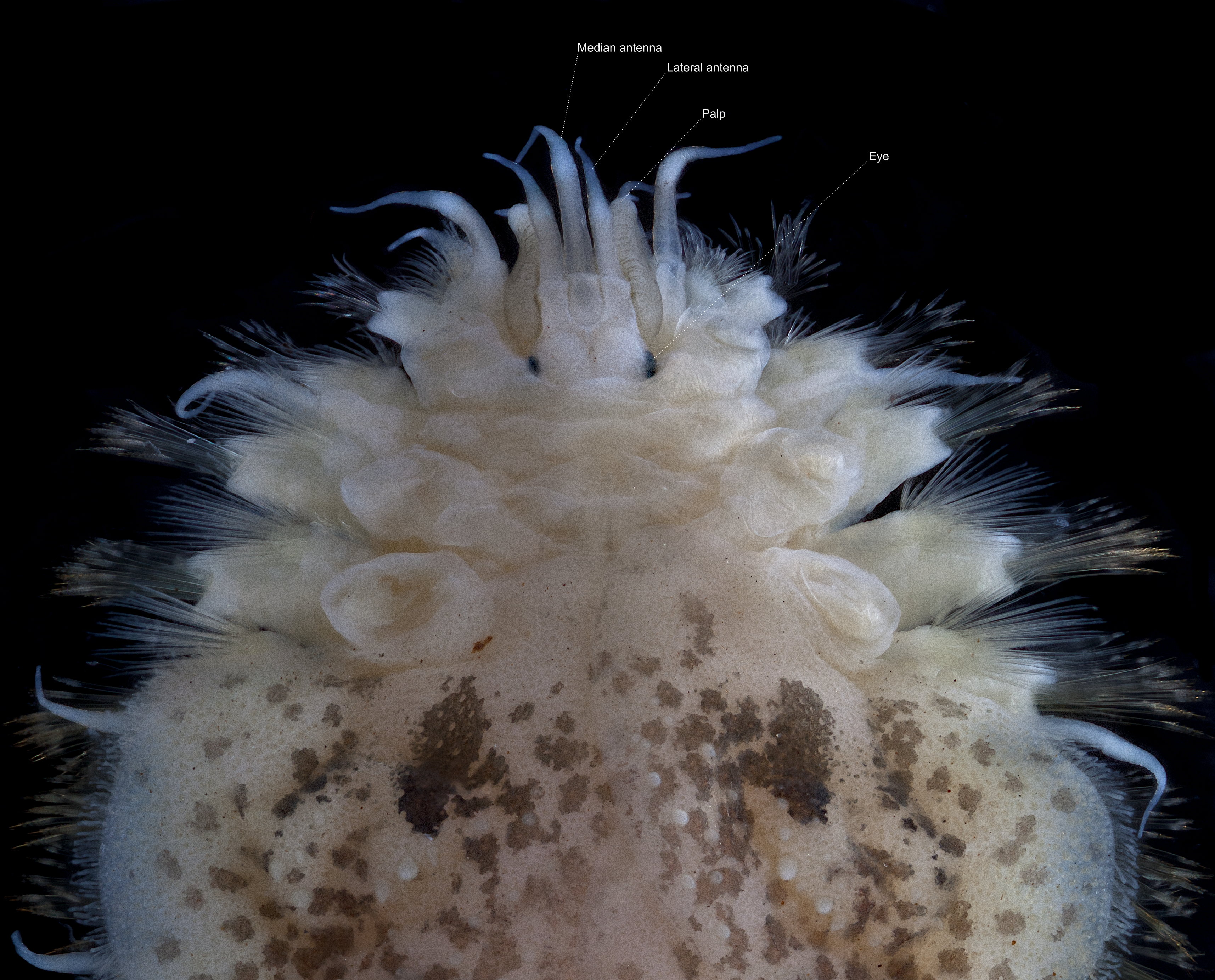|
Macrochaeta Natalensis
''Macrochaeta natalensis'' is a polychaete which belongs to the Acrocirridae family. The body of this worm consists of a head, a cylindrical, segmented body and a tail piece. The head consists of a prostomium The prostomium (From Ancient Greek, meaning "before the mouth"; plural: prostomia; sometimes also called the "acron") is the cephalized first body segment in an annelid worm's body at the anterior end. It is in front of (but does not include) th ... (part of the mouth's opening) and a peristomium (area around the mouth) and utilized paired appendages (palps, antennae and cirri). The scientific name of this species was first published in 1996 by Hartmann-SchröderBellan, G. (2011). Macrochaeta natalensis Hartmann-Schröder, 1996. In: Read, G., Fauchald, K. (Ed) (2011). World Polychaeta database. Based on information from the World Register of Marine Species, found at http://www.marinespecies.org/aphia.php?p=taxdetails&id=129747 References Terebellida Animals descr ... [...More Info...] [...Related Items...] OR: [Wikipedia] [Google] [Baidu] |
Polychaete
Polychaeta () is a paraphyletic class of generally marine annelid worms, commonly called bristle worms or polychaetes (). Each body segment has a pair of fleshy protrusions called parapodia that bear many bristles, called chaetae, which are made of chitin. More than 10,000 species are described in this class. Common representatives include the lugworm (''Arenicola marina'') and the sandworm or clam worm ''Alitta''. Polychaetes as a class are robust and widespread, with species that live in the coldest ocean temperatures of the abyssal plain, to forms which tolerate the extremely high temperatures near hydrothermal vents. Polychaetes occur throughout the Earth's oceans at all depths, from forms that live as plankton near the surface, to a 2- to 3-cm specimen (still unclassified) observed by the robot ocean probe ''Nereus'' at the bottom of the Challenger Deep, the deepest known spot in the Earth's oceans. Only 168 species (less than 2% of all polychaetes) are known from ... [...More Info...] [...Related Items...] OR: [Wikipedia] [Google] [Baidu] |
Acrocirridae
Acrocirridae is a family of polychaete worms. Acrocirrids are detritivores (deposit feeders), catching falling particles with numerous long prostomial tentacles. There are eight known genera, and at least 21 described species and subspecies within the Acrocirridae. The acrocirrids are primarily benthic (seabed-dwelling) animals, but at least two genera (''Swima'' and ''Teuthidodrilus'') appear to have evolved or adapted to a pelagic (free-swimming) habitat. Systematics Following is a list of genera and species within the family Acrocirridae: * Genus '' Acrocirrus'' Grube, 1873 ** '' Acrocirrus aciculigerus'' Kudenov, 1976 ** '' Acrocirrus bansei'' Magalhães & Bailey-Brock, 2012 ** '' Acrocirrus columbianus'' Banse, 1979 ** '' Acrocirrus crassifilis'' Moore, 1923 ** '' Acrocirrus frontifilis'' (Grube, 1860) ** '' Acrocirrus heterochaetus'' Annenkova, 1934 ** '' Acrocirrus incisa'' Kudenov, 1975 ** '' Acrocirrus muroranensis'' Okuda, 1934 ** '' Acrocirrus occipitalis'' Banse, 19 ... [...More Info...] [...Related Items...] OR: [Wikipedia] [Google] [Baidu] |
Prostomium
The prostomium (From Ancient Greek, meaning "before the mouth"; plural: prostomia; sometimes also called the "acron") is the cephalized first body segment in an annelid worm's body at the anterior end. It is in front of (but does not include) the mouth, being usually a small shelf- or lip-like extension over the dorsal side of the mouth. The prostomium together with the peristomium, which includes the mouth and pharynx, make up the annelid head. Description The prostomium is part of the head and holds at least part of the brain and often bears sensory structures such as the eyes, antennae and palps. It may function like a kind of overlip when the animal is feeding. The prostomium bears many important taxonomic characters and its shape and composition are important for annelid systematics. In addition to the eyes, antennae and palps, the prostomium can possess appendages such as tentacles or cirri. Moreover, some polychaete Polychaeta () is a paraphyletic class of gener ... [...More Info...] [...Related Items...] OR: [Wikipedia] [Google] [Baidu] |
Peristomium
The peristomium is the first true body segment in an annelid worm's body in the anterior end. It is directly behind the prostomium and contains the mouth, tentacular cirri, and sometimes feeding palps, which may instead occur on the prostomium. If an eversible pharynx is present, it is contained in this segment as well, and can fill up to 20 segments when inverted, depending on the species. The prostomium and peristomium can be variously fused, either completely distinct, or comprising a joint structure of a peristomial ring and a tentacular crown. See also *Prostomium The prostomium (From Ancient Greek, meaning "before the mouth"; plural: prostomia; sometimes also called the "acron") is the cephalized first body segment in an annelid worm's body at the anterior end. It is in front of (but does not include) th ... * Pygidium References {{Reflist Annelid anatomy ... [...More Info...] [...Related Items...] OR: [Wikipedia] [Google] [Baidu] |
Terebellida
Terebellida make up an order of the Polychaeta class, commonly referred to as "bristle worms". Together with the Sabellida, the Spionida and some enigmatic families of unclear taxonomic relationship (e.g. the Saccocirridae), they make up the subclass Canalipalpata, one of the three main clades of polychaetes. Like most polychaetes, almost all members of the ''Terebellida'' are marine organisms. Most are small, sessile detritivores (deposit feeders) which live in small tubes they build from mud or similar substrate, or burrow in the sand. Their central nervous system displays characteristic apomorphies. Systematics There is little consensus on the number of families. Some treatments accept as little as five, while other authors list over a dozen. Here, the more inclusive view of the Terebellida is followed, based on a major review of polychaete systematics. Cladistic studies have hitherto only analyzed a rather small proportion of polychaetes; hence it may be that so ... [...More Info...] [...Related Items...] OR: [Wikipedia] [Google] [Baidu] |

